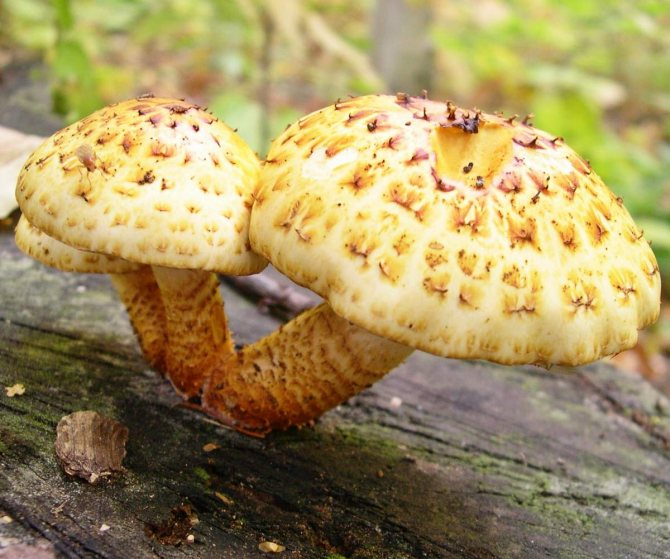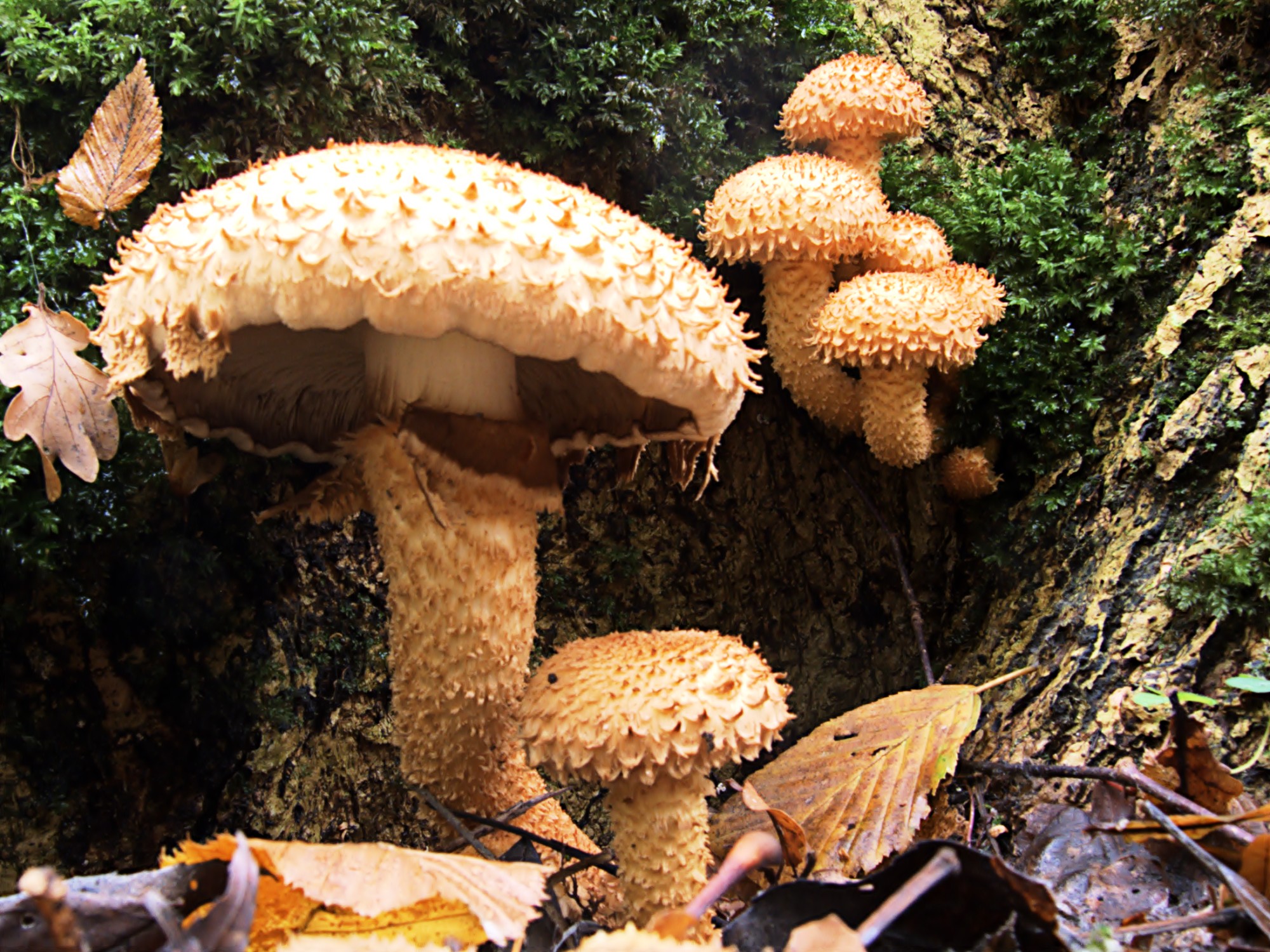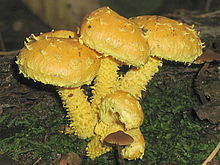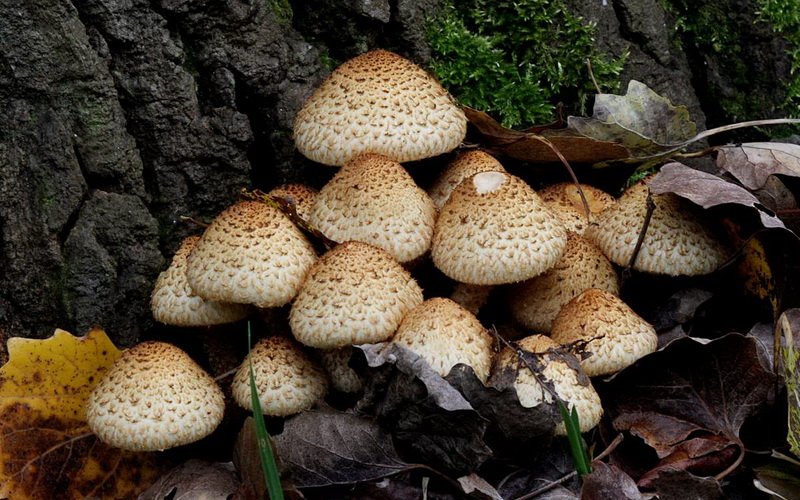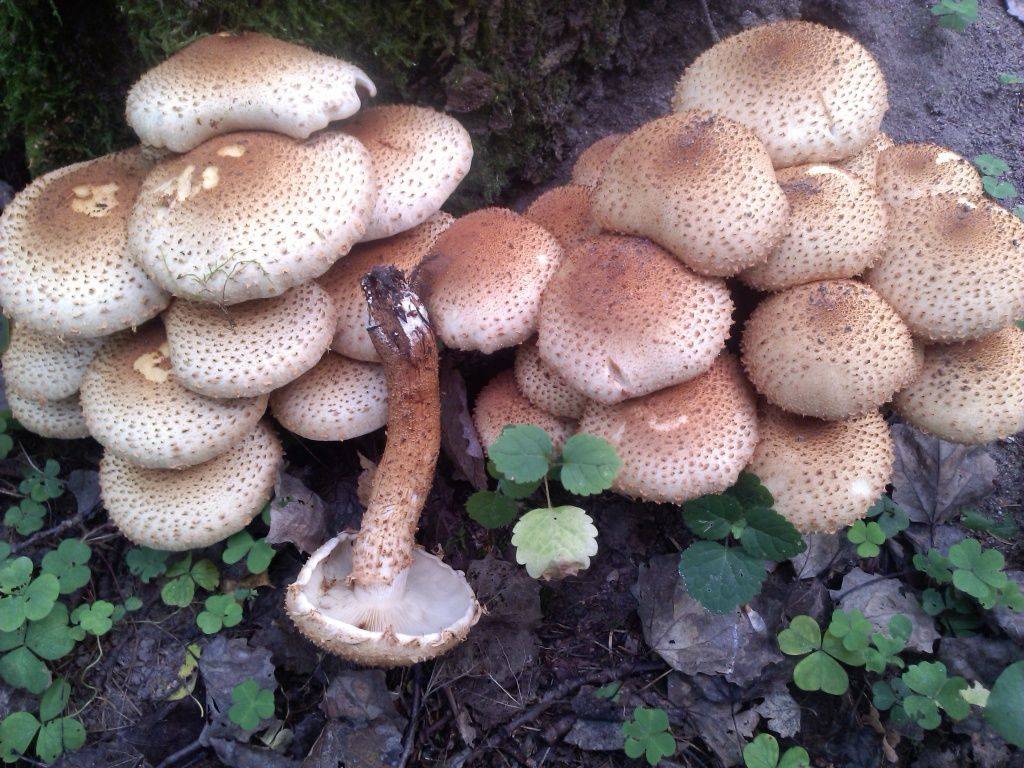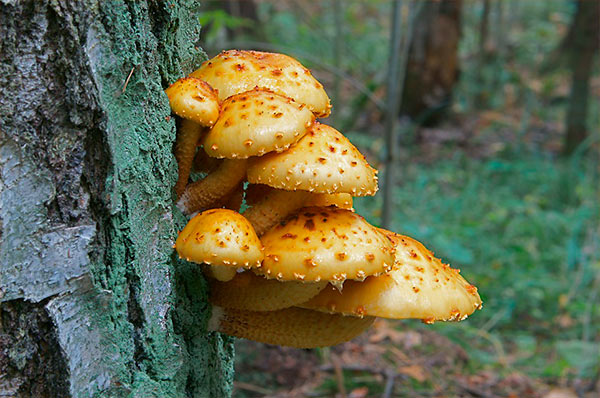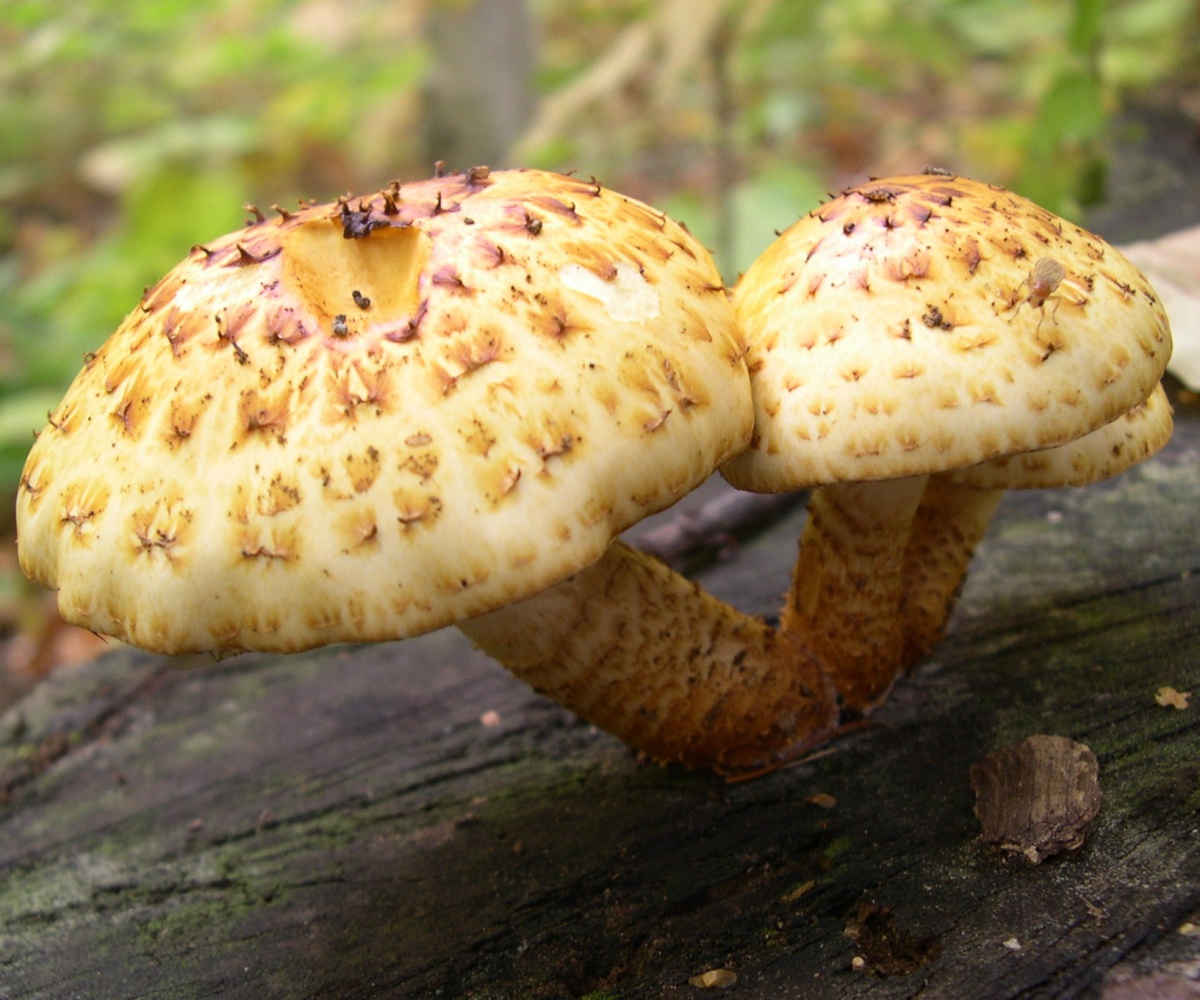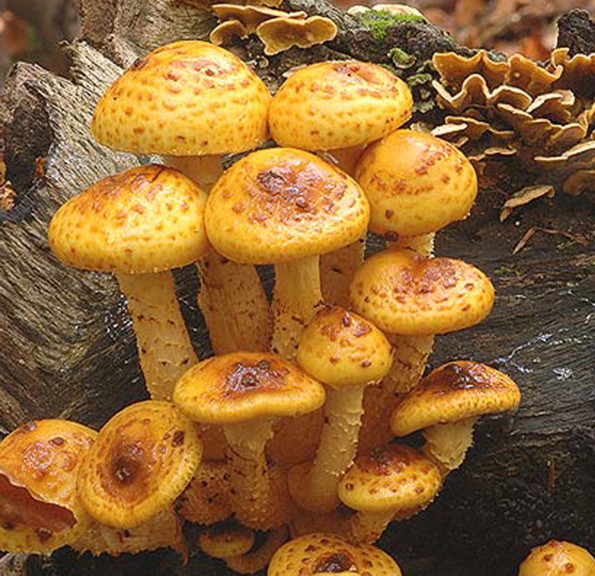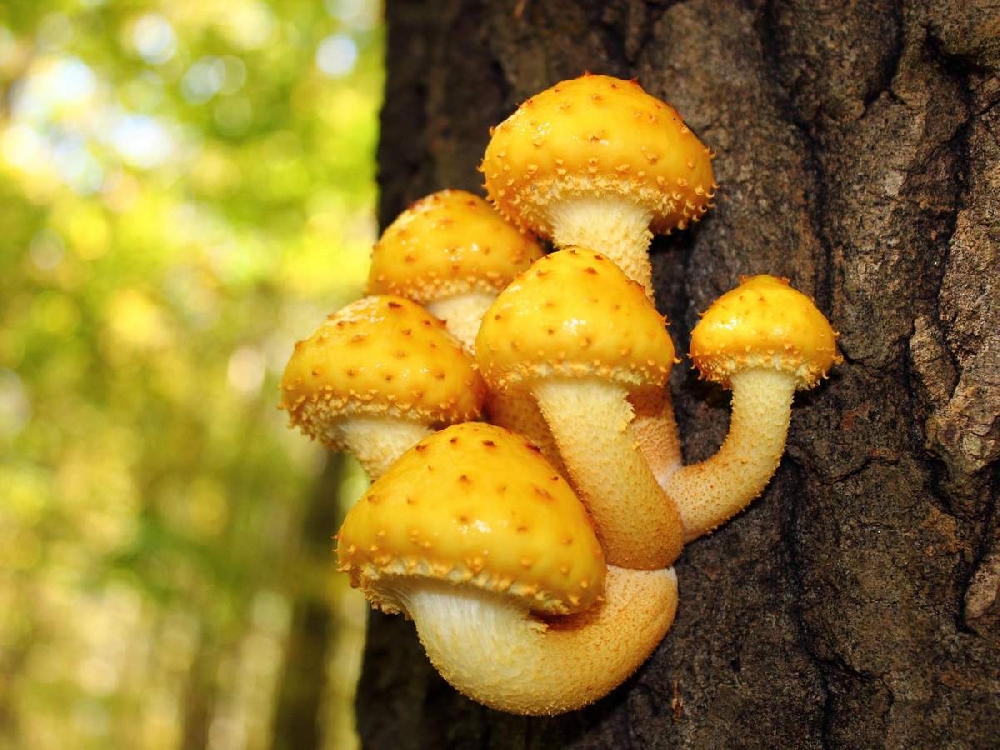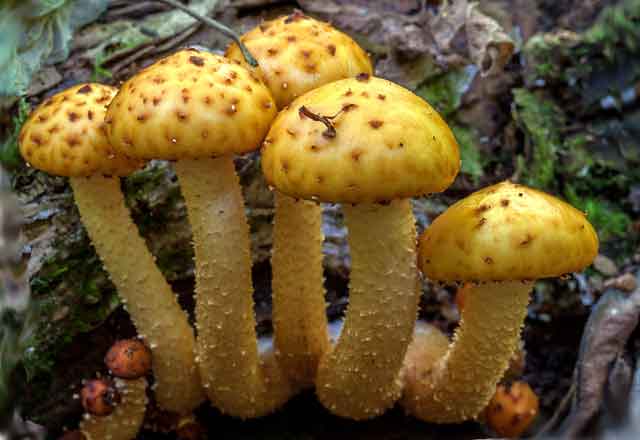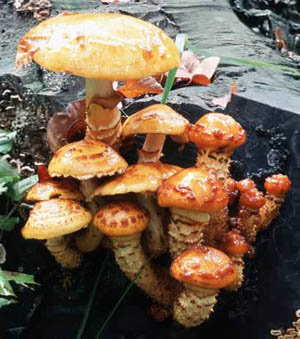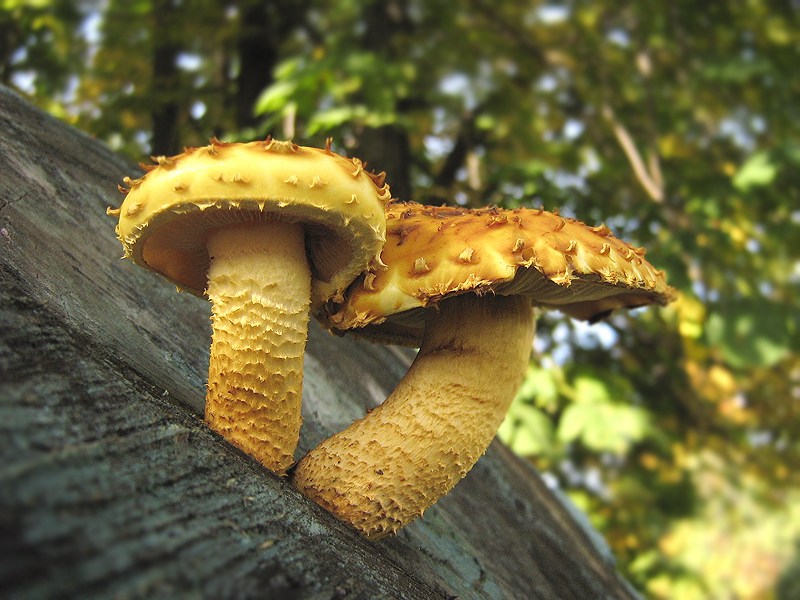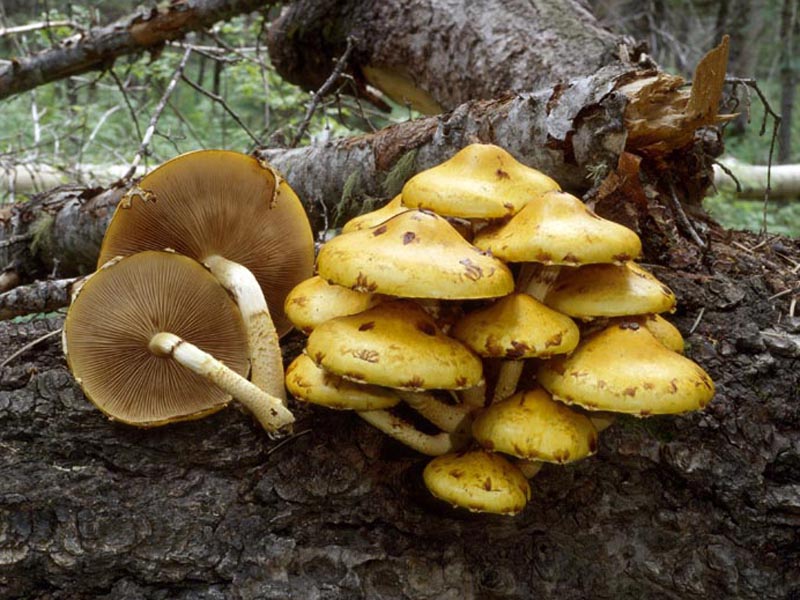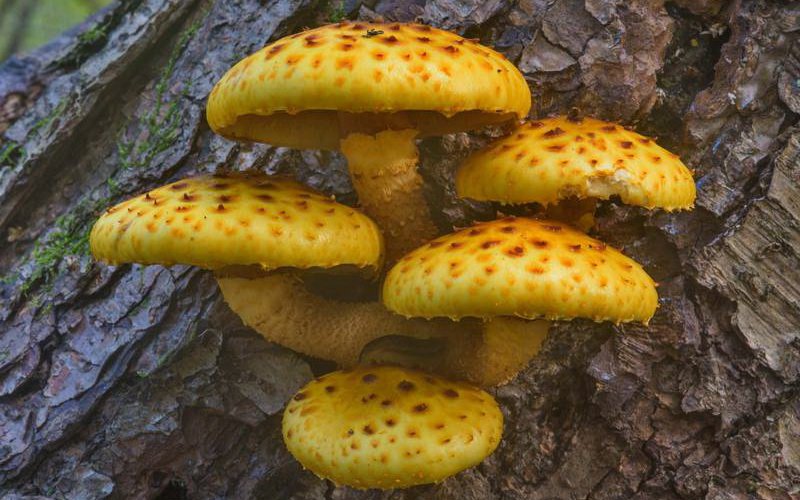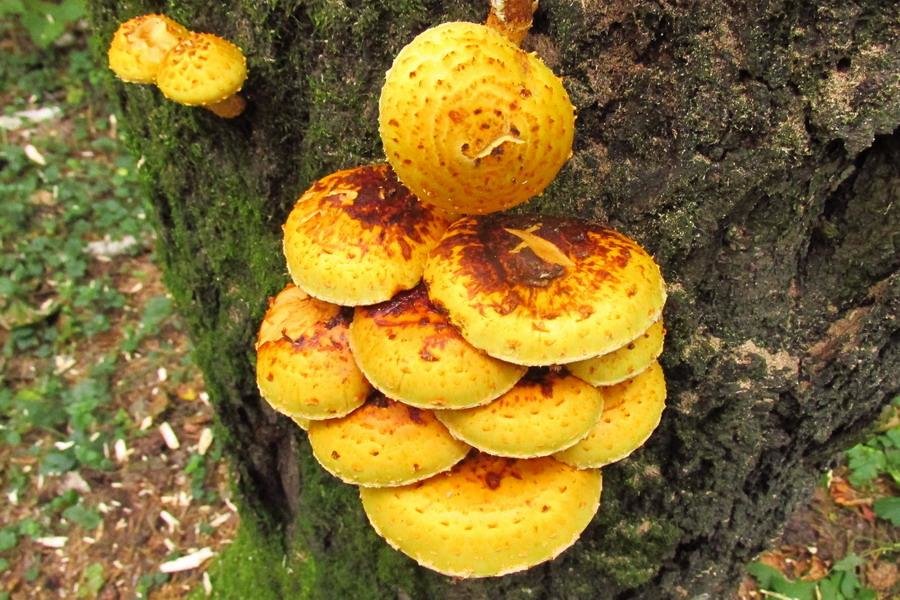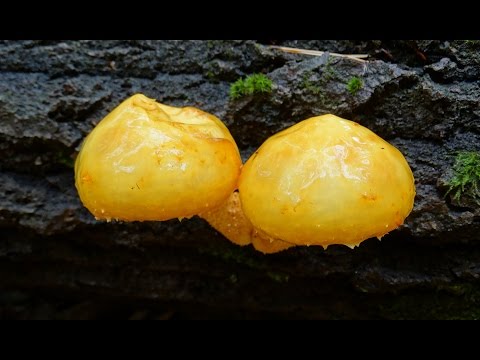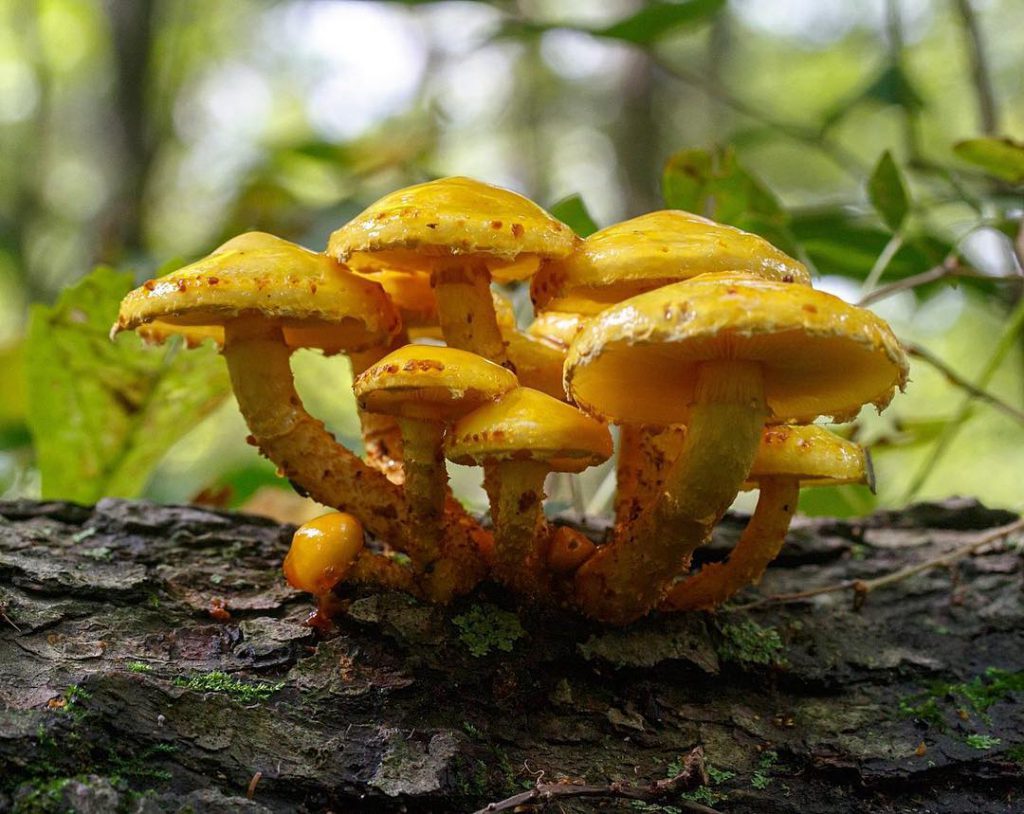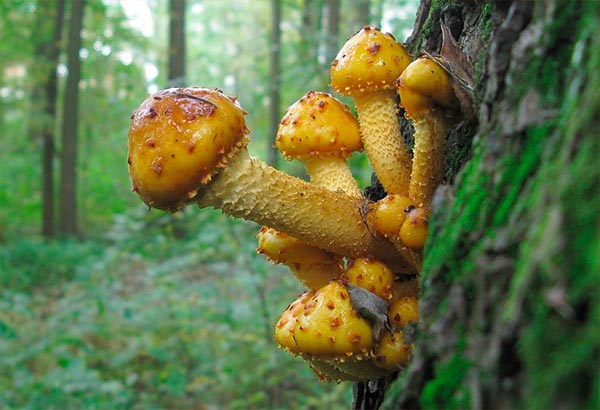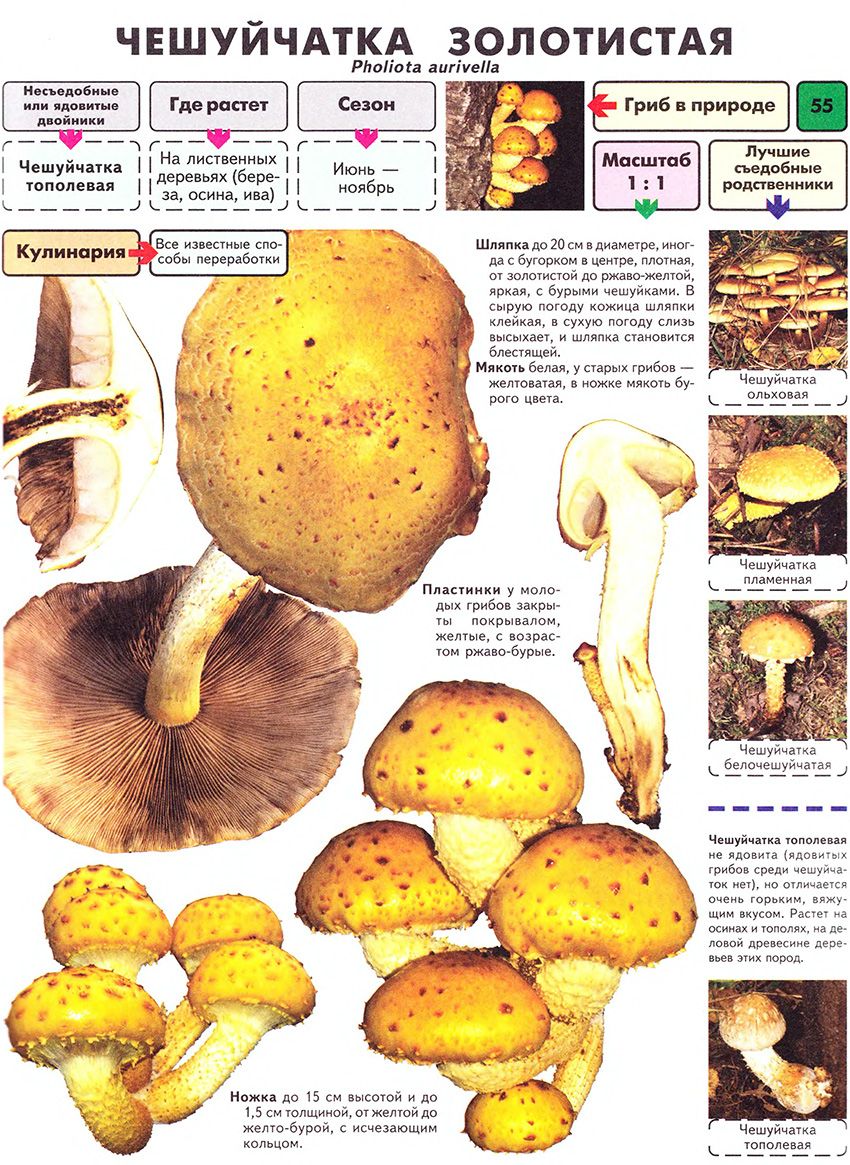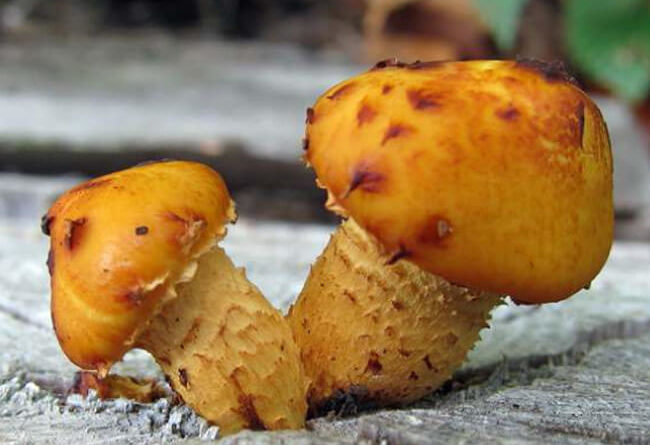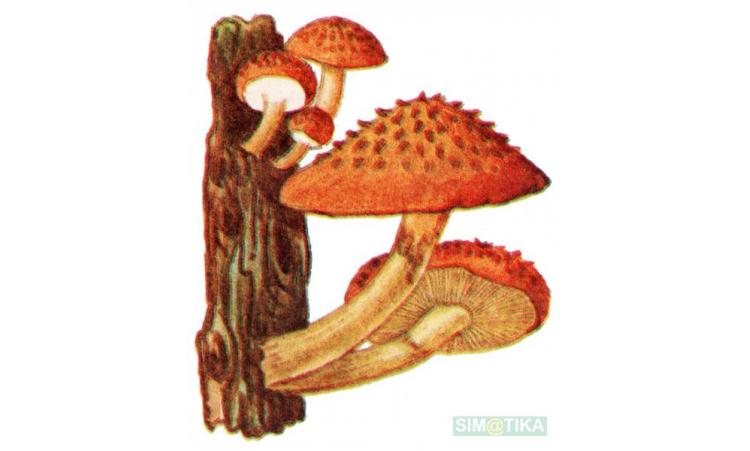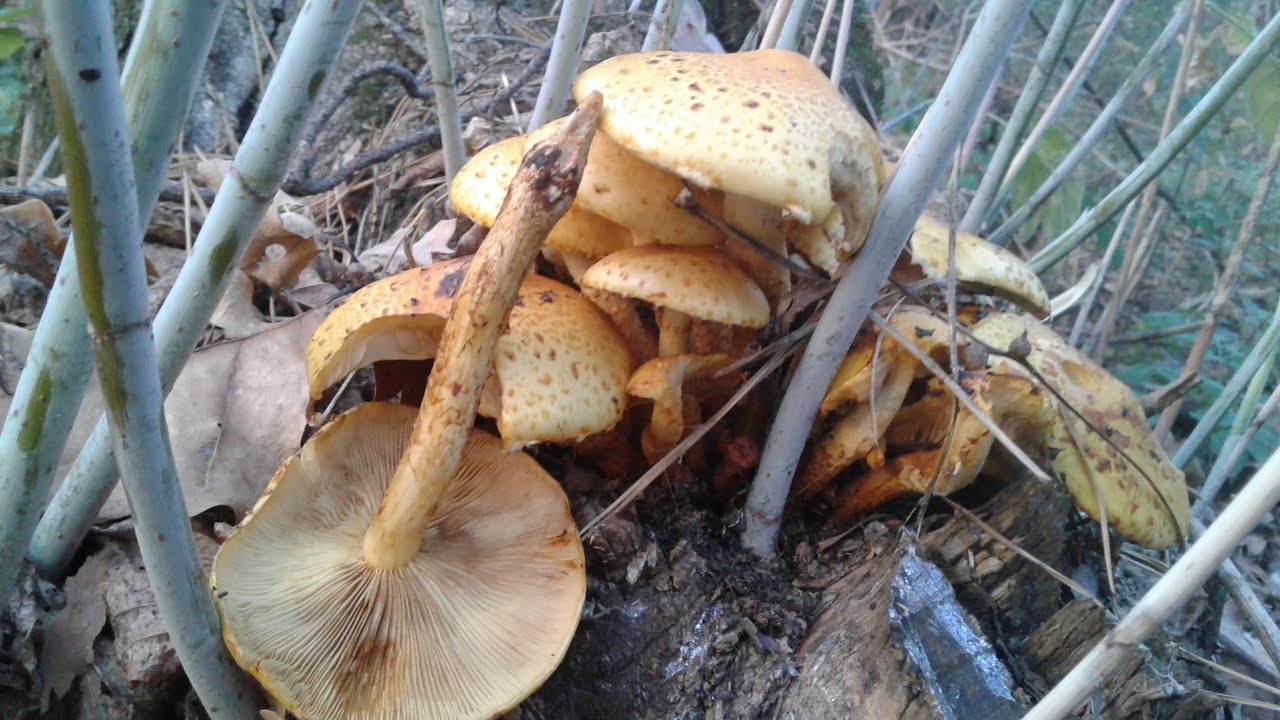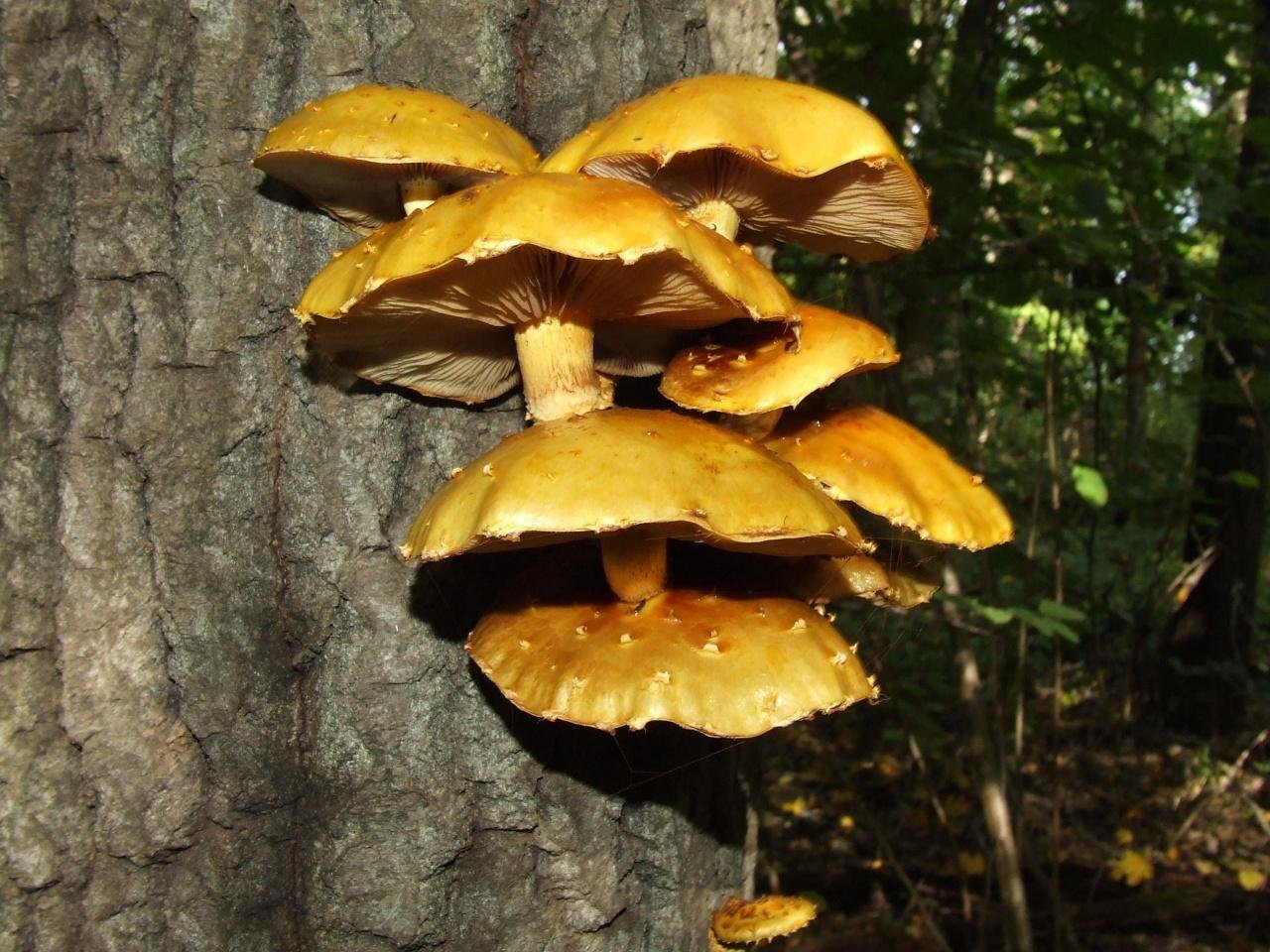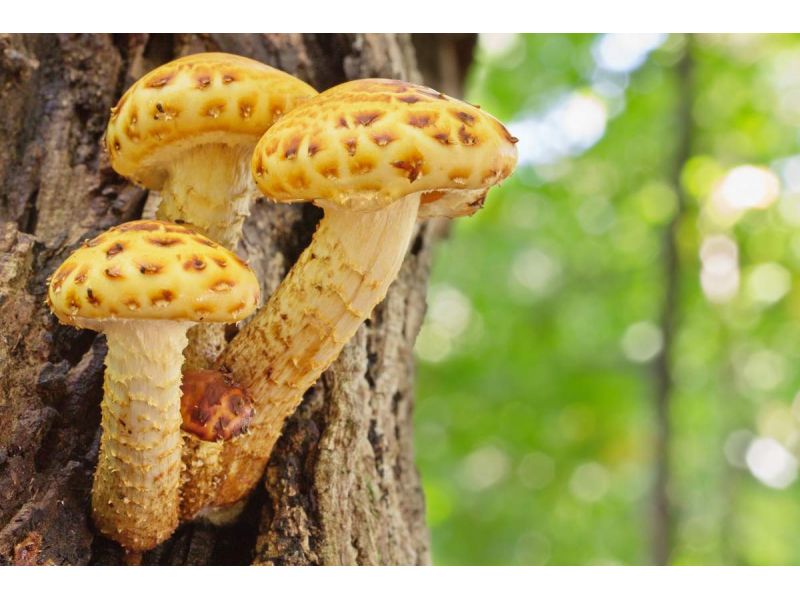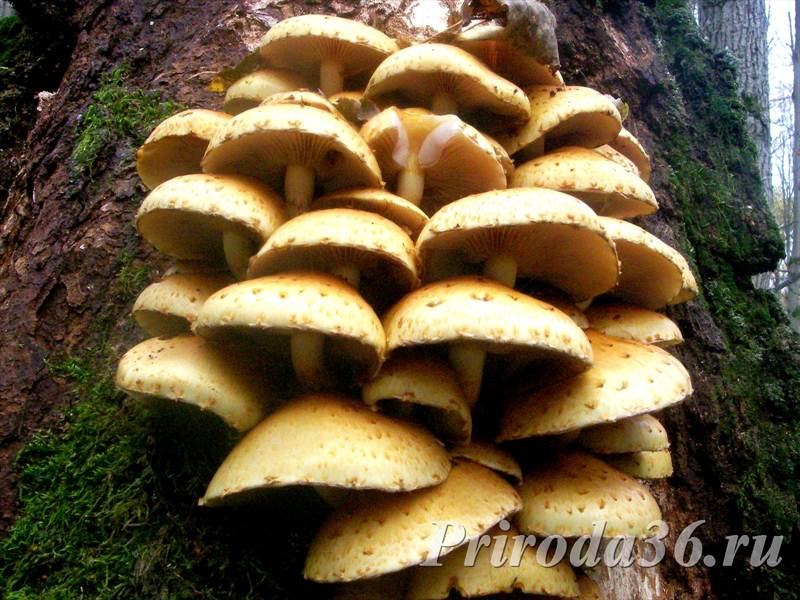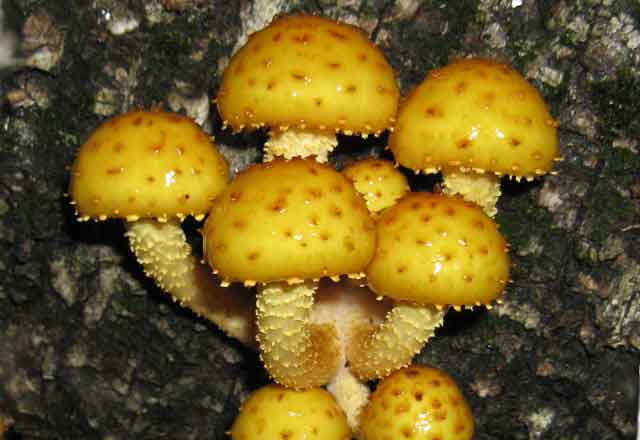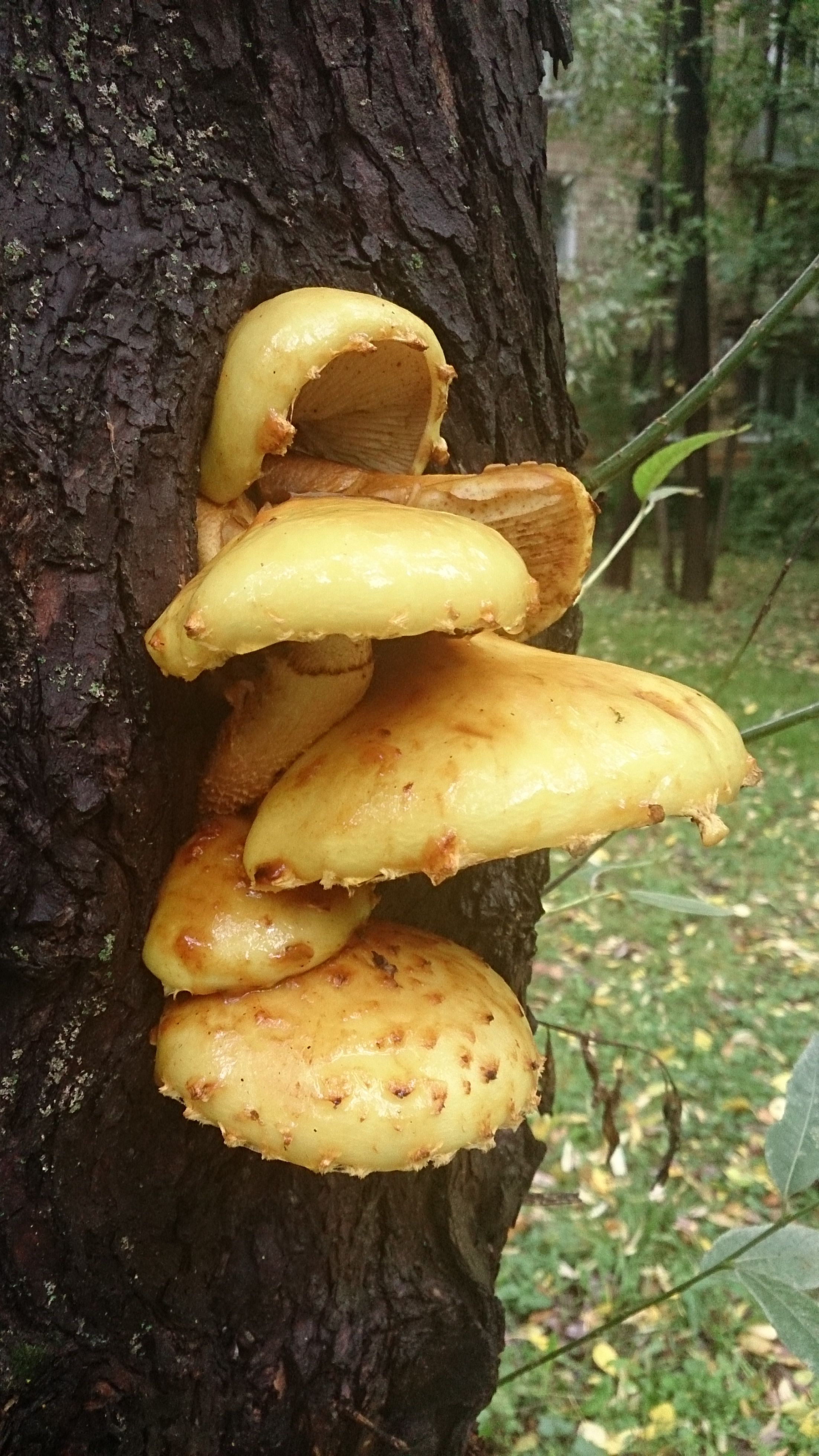False doubles of royal honey agarics
The golden scales have an external resemblance to some poisonous mushrooms, therefore, before going into the forest, it is necessary to study the features of the species. For example, a false honey fungus or firefly does not have characteristic scales, but it grows on old ashes and fireplaces overgrown with grass. In addition, the pulp of such a mushroom exudes an unpleasant odor, these signs are enough in order not to be mistaken with the choice of forest gifts and not harm your health.
Common inedible counterparts of the royal mushroom are the following types of mushrooms growing in the forest:
- The mucous scales outwardly resemble the described mushroom, however, the caps of young fruiting bodies have a bell-shaped shape, with age their edges rise, which is uncharacteristic for an edible species. During the rainy season, mushrooms become sticky and slimy, living up to their name. You can also distinguish an inedible species by the small number of scales, and it is found exclusively on rotted wood or near dead wood.
- Experts call cinder flakes a false royal honey fungus; at a young age, fruiting bodies have a hemispherical cap, later it becomes prostrate. The color of the mushroom is very bright and varies from orange-brown to reddish, the edges of its legs are covered with small scales. But this species does not have a ring characteristic of real honey agarics, therefore it is difficult to confuse it with golden flakes.
- Much more common in the forest is common scaly, very similar to the considered type of mushroom. Despite the fact that this mushroom has medicinal properties, it is not recommended to eat it. The opium contained in the pulp has an unpredictable effect on the human body. Distinctive features of the species are the hemispherical shape of the cap, tough flesh and paler color compared to the royal mushroom.
Golden prickly mushrooms are also often called willow, because they are found on willows. They can be confused with some inedible mushrooms:
- Fireball. It is found on old overgrown ashes and fireplaces. The double has a defiant coloration, a bitter taste and a cloying smell. This is a mushroom hazardous to health.
- The scales are mucous. The shape of the cap of both mushrooms is similar. In wet weather, the double is slimy and sticky. The leg is empty inside, without a ring on top. These representatives of the fungal flora are found on the decayed remains of trees from late summer to the first frost.
- Cinder flakes. A bright brick-red cap with remnants of a filmy bedspread at the edges. The leg is covered with brownish scales, especially frequent below. There is no ring on it.
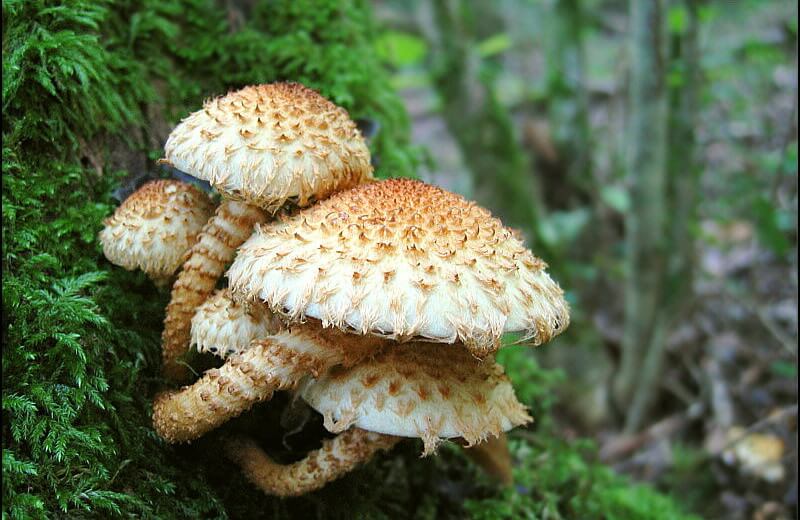
Golden prickly mushrooms are also often called willow, because they meet on willows
Golden scale recipes
Before preparing the main course, royal mushrooms need preliminary culinary processing. The legs are cut almost completely, then the mushrooms are soaked for at least 20 minutes to completely remove debris and insects that have got into the plates. Then they are boiled in salted water and put in a colander so that the glass has excess moisture. It is believed that during preliminary cooking it is necessary to put an onion in a saucepan: if it darkens, then a poisonous honey fungus has "crept in" among the mushrooms. Unfortunately, it is impossible to identify a poisonous individual in this way.
Golden Scale Recipes:
Pickled mushrooms... Prepared mushrooms are boiled 2 more times for 20 minutes, each time rinsing with running water and filling with new ones. The jars are sterilized along with the lids, while the marinade is boiled. Proportions: 1 kg of mushrooms, pure water - 600 ml, salt - 2 tablespoons, the same amount of sugar, 12 black peppercorns, 5 bay leaves and vinegar 9% - 2 tablespoons.The marinade is boiled for 5 minutes, 3-4 crushed large cloves of garlic are added, boiled for another 2 minutes. Mushrooms are transferred to jars, poured with boiling marinade and the lids are tightened. Preservation is put to cool upside down, under the blanket.
Golden flakes in sour cream... Pre-prepared mushrooms in an amount of 1 kg are spread in a colander or paper towels to remove the remaining moisture, cut a large onion into rings and fry it in vegetable oil until golden brown. Spread the mushrooms, fry for 15 minutes, pour half a glass of fatty, preferably rustic, sour cream into the pan, and stew for 30 minutes. Then sprinkle the fry with chopped herbs - dill and parsley, cover with a lid and let the dish brew for at least 15 minutes. Serve with fried or boiled potatoes.
Chicken soup with honey agarics... Honey mushrooms are prepared in the usual way, boiling for at least 20 minutes. Finely chop the onions and carrots - it is more convenient to use a blender, as when grated on a grater, the onions "sting" the eyes. Cut the potatoes into small cubes. It is advisable to finely chop the chicken meat and boil it: put the chicken in boiling water, supplement the container with a whole onion, boil for 15 minutes. At this time, the onion-carrot mixture is fried in a pan with sunflower oil, mushrooms are added and also fried, 15 minutes. Remove the onion from the chicken broth, lay the potatoes, fry in full and cook until tender. To improve the taste, bay leaves, black and allspice peppers, and salt are used. It is better to sprinkle with herbs the soup, already poured into plates.
Royal mushrooms in a slow cooker... In a modern multicooker pan, you can pre-cook royal mushrooms and prepare a main course. The washed mushrooms are laid out in a bowl, put on a simmer for 30 minutes, and then laid out on a steamer device. While the liquid is draining, chop the onion and carrots. Preheat the bowl on the "frying" mode and pour all the ingredients into it together. The dish can be tasted after 40 minutes - salt, pepper and add herbs to taste.
Salad with golden flakes... Boiled chicken fillet marinated in soy sauce. Boil diced potatoes, cut carrots. Pickled mushrooms are washed, cut into identical pieces. Mix potato cubes with carrots, mushrooms and fillet pieces. A large onion is cut into rings, each ring is rolled in flour, fried until golden brown, the parsley is washed and torn by hand. The salad is garnished with fried onion rings and parsley sprigs.
Diet puree soup... Cut the potatoes, boil until half cooked, sauté onions and carrots in a pan with a minimum amount of sunflower oil. Pre-prepared mushrooms are fried with onions and carrots for 20-25 minutes under a lid. The potatoes are removed from the water - the broth is not poured out, combined with frying, chopped with a blender. Bring the water to a boil, put the grated mass into it, mix well and leave to infuse under the lid, pouring in half a glass of heavy cream. Salt to taste, herbs are added to each plate.
From golden scales, you can prepare a filling for pies, add to a casserole. Mushrooms are harvested for the winter not only by pickling, but also by freezing. Pre-treatment of thawed mushrooms is carried out in the same way as fresh ones.
Scale golden (Pholiota aurivella)
Synonyms:
- Royal honey
- The scale is thick
- Sebaceous scale
- Pholiota adiposa
- Luimo
- Huangsan
- Tsiermo
- Feilinier
- Hypodendrum adiposum
- Dryophila adiposa
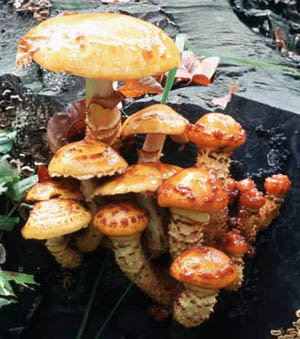 Golden scaly (Pholiota aurivella) is a mushroom of the Strophariev family, belonging to the Scale genus. Pholiota aurivella Scale golden, growing in large groups on or near deciduous trunks. Fruiting - August-September (in the Primorsky Territory - from May to September). Distributed throughout Russia.
Golden scaly (Pholiota aurivella) is a mushroom of the Strophariev family, belonging to the Scale genus. Pholiota aurivella Scale golden, growing in large groups on or near deciduous trunks. Fruiting - August-September (in the Primorsky Territory - from May to September). Distributed throughout Russia.
The cap is 5-18 cm in ∅, broadly bell-shaped, flat-round with age, dense, dirty golden or rusty yellow with reddish flaky scales scattered over the entire surface. The plates are wide, adhered to the peduncle with a tooth, at first light straw-yellow, when ripe they are olive-brown-brown.
The pulp is whitish-yellowish.
Leg 7-10 cm high, 1-1.5 cm ∅, dense, yellowish-brown, with brown-rusty scales and a fibrous ring that disappears in maturity.
Season and habitat of the fungus
Scale golden bears fruit from late spring to autumn, grows mainly in groups, in deciduous forests, on dead wood. The most common mushroom of this species can be found in China, but golden scales are also common in Russia, Japan, European countries, Australia and North America.
Edibility
Golden scaly (Pholiota aurivella) belongs to edible mushrooms. Its fruiting bodies contain a large amount of fat, protein, vitamins, sugar, mineral components (among which there are sodium, magnesium, calcium, ferrum). There are 3 times more of these components in the pulp of the described mushroom than in other varieties of mushrooms.
Golden flakes are superior to other types of useful and medicinal mushrooms in the amount of amino acids essential for the human body.
Similar types and differences from them
Golden scales have no similar species.
Video about the mushroom Golden scales:
Other information about the mushroom
The surface of the fruit bodies of golden scales (Pholiota aurivella) is covered with mucus, which is of great benefit to the human body, helping to restore energy balance and mental abilities. The experiments carried out by mycologists made it possible to determine that the pulp of sebaceous scales has an immunostimulating effect. Eating this mushroom in food helps to comprehensively regulate the activity of the immune system of the human body.
How to cook golden flakes
Second courses and pickled preparations are prepared from golden flakes, but only after preliminary boiling of the mushrooms for 15-20 minutes. They go well with meat, potatoes and vegetables. Suitable for stews, pie fillings and assorted mushrooms. For the winter table, mushrooms are harvested in various ways:
Stews from royal honey mushrooms with the addition of milk or sour cream have high taste.
How to pickle golden flakes
Marinating golden flakes is the most popular culinary method. At home, you can prepare a canning that will not be inferior to the taste of the store.
The algorithm of actions is as follows:
- Mushrooms are cleaned, sorted by size, washed thoroughly and boiled in salted water for 20 - 25 minutes.
- Thrown back in a colander, allow the water to drain.
- They are laid out in prepared, pre-sterilized jars.
- Add cloves, bay leaves, peppercorns, peeled garlic cloves.
- Prepare the marinade: add 2 tablespoons to 1 liter of water. l. sugar, 2.5 tbsp. l. not iodized salt. After boiling, table vinegar is added - 4 - 5 tbsp. l.
- Prepared flakes are poured with marinade and immediately rolled into jars.
How to fry golden flakes with onions
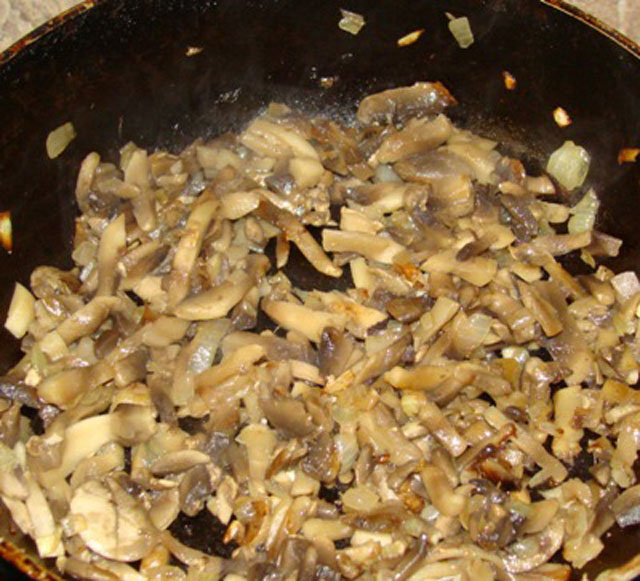
Cooking the lightest and at the same time delicious dish from golden flakes will not take much time, but it will provide invaluable benefits to the body. Cooking algorithm:
- The mushrooms brought from the forest are cleaned, washed and cooked in salted water for 20 - 25 minutes.
- The mushroom mass is thrown into a colander, allowed to drain completely and put into a pan with vegetable oil.
- Fry over high heat under a closed lid.
- When the moisture evaporates, add onion rings, salt and pepper.
- The dish is brought to readiness and immediately served on the table.
Description of golden scales
The mushroom has received many names, but most often it is called the royal mushroom or willow tree.It is often confused with other species, therefore, before going into the forest, it is better to familiarize yourself with the features of the appearance of flakes.
How do they look
Experienced mushroom pickers often compare golden flakes with summer mushrooms, since outwardly they are very similar. In addition, the mushroom is larger than its counterparts, for which it received the loud name "Royal mushroom"
Its bright fruiting body looks spectacular against the background of dark bark and immediately attracts attention.

The structure and features of the species pholiota aurivella
Thanks to the diameter of the cap, the mushroom really justifies the title of "royal", since it can reach 20 cm. Young specimens boast a wide-bell-shaped cap, which, as it grows, transforms into a flat-round one. The skin covering its surface is usually rusty yellow or dirty golden in color. In addition, a distinctive feature is the reddish scales scattered over its entire surface.
On the back of the cap there are wide plates that grow together with the stem. As they mature, their color changes from light straw to olive brown. In the section, you can see that the flesh of the scale has a whitish-yellow tint. The upper part rests on a dense yellow-brown stalk (7-10 cm long), which is covered with rusty-brown scales. You can also find a fibrous ring that disappears with age.

Edible or not
Royal mushroom is ranked in the 4th category of mushrooms, i.e. recognized as conditionally edible. Because of this characteristic, it is not eaten throughout much of Europe. This trend does not apply to experienced mushroom pickers in Russia, who consider willow to be a worthy mushroom for consumption. And in the Land of the Rising Sun, hats are an essential ingredient in most national dishes.
Note! The main thing is to properly process the raw materials, namely, boil for 15-20 minutes. After that, they will be a great addition to vegetable stews, pizzas, salads and other dishes.
Definitioner
- Basidia (Basidia)
-
Lat. Basidia. A specialized structure of sexual reproduction in fungi, inherent only in Basidiomycetes. Basidia are terminal (end) elements of hyphae of various shapes and sizes, on which spores develop exogenously (outside).
Basidia are diverse in structure and method of attachment to hyphae.
According to the position relative to the axis of the hypha, to which they are attached, three types of basidia are distinguished:
Apical basidia are formed from the terminal cell of the hypha and are located parallel to its axis.
Pleurobasidia are formed from lateral processes and are located perpendicular to the axis of the hypha, which continues to grow and can form new processes with basidia.
Subasidia are formed from a lateral process, turned perpendicular to the axis of the hypha, which, after the formation of one basidium, stops its growth.
Based on morphology:
Holobasidia - unicellular basidia, not divided by septa (see Fig. A, D.).
Phragmobasidia are divided by transverse or vertical septa, usually into four cells (see Fig. B, C).
By type of development:
Heterobasidia consists of two parts - hypobasidia and epibasidia developing from it, with or without partitions (see Fig. C, B) (see Fig. D).
Homobasidia is not divided into hypo- and epibasidia and in all cases is considered holobasidia (Fig. A).
Basidia is the place of karyogamy, meiosis and the formation of basidiospores. Homobasidia, as a rule, is not functionally divided, and meiosis follows karyogamy in it. However, basidia can be divided into probasidia - the site of karyogamy and metabasidia - the site of meiosis. Probasidium is often a dormant spore, for example in rust fungi. In such cases, probazidia grows with metabasidia, in which meiosis occurs and on which basidiospores are formed (see Fig. E).
See Karyogamy, Meiosis, Gifa.
- Pileipellis
-
Lat. Pileipellis, skin - differentiated surface layer of the cap of agaricoid basidiomycetes.The structure of the skin in most cases differs from the inner flesh of the cap and may have a different structure. The structural features of pileipellis are often used as diagnostic features in descriptions of fungi species.
According to their structure, they are divided into four main types: cutis, trichoderma, hymeniderma and epithelium.
See Agaricoid fungi, Basidiomycete, Cutis, Trichoderma, Gimeniderm, Epithelium.
- Trichoderma (Trichoderma)
-
The type of cap skin, usually consists of straight, septate elements located more or less perpendicular to the surface and laid both at the same and at different levels; the ends of the hyphae can be morphologically modified and represent dermatocystids. The surface of the cap is velvety to almost felt.
Lat. Trichoderm.
Trichoderma, in turn, is subdivided into intertwined trichoderma and irregular trichoderma.
Intertwined trichoderm (Intricate trichoderm) - trichoderm, consisting of intertwined hyphae, located not parallel to each other and forming a tomentose pubescence.
Irregular trichoderm - Trichoderma, consisting of irregularly branching hyphae.
See Dermatotsistida, Hypha, Septa.
- Cutis
-
The type of cap skin, consists of creeping non-gelatinized hyphae located parallel to the surface. The surface of the cap looks smooth.
Lat. Cutis.
See Gifa.
Places and season for collecting royal honey mushrooms
In Russia, this species of honey agaric grows in deciduous and coniferous boggy forests. They choose decaying trunks or old tree stumps. These are alder, willow, less often birch. Their favorite places are also the remains of the roots of dead trees.
Fruiting of these common mushrooms occurs at the end of August - mid-October. But sometimes golden hats can be found even in July. And in the Primorsky Territory they are harvested from the end of May to October. They usually grow in large families. And due to the coincidence of the collection dates with the appearance of false honey agarics, there is a danger of confusing poisonous twins with benign mushrooms.
Scale golden - Pholiota aurivella
Written by Nikolay Budnik and Elena Meck.
Scale golden - a beautiful and juicy mushroom. It is not for nothing that this scale is also called the royal honeydew. It grows singly or in small groups on the trunks and stumps of deciduous trees.
On Ulom Zheleznaya, we rarely met this mushroom. The mushroom is edible, and you will have to try the Golden Scale somehow.

1. Golden scales settle on tree trunks.

2. Usually it is a birch.

3.. but there are trees and other hardwoods.

4. Trunks of trees can be fallen, dead.

5. . and can be growing, simply weakened.

6. If the mushroom grows on a vertical stem, its stem bends to make the cap look up.

7. The hat is covered with rare dark scales that look beautiful against a bright yellow background.

8. By old age, the edges of the cap droop, become sluggish.

9. Along the edge of the cap there are visible remnants of a foil blanket.

10. Plates are even, rather frequent, yellow-ocher color.

11. Dark spots sometimes appear on the plates.

12. By old age, the records darken.

13. This is how the plates are attached to the stem.

14. Here you can see it up close.

15. Above, the leg is smooth, almost the same color as the cap.

16. Below it is covered with rags, sometimes very noticeable.

17. On the leg you can see the remains of a private coverlet, which at first covered the plates.

18. This is what the leg looks like up close.

19. On the cut, the flesh is dense, but in the leg it is just tough.

20. This is the flesh of the mushroom close up.

21. Golden scales are a bright mushroom that adorns the autumn forest.
2017 film about Golden Scale
A film about how we fried Golden Scale
The taste and nutritional value of royal honey agarics
Golden flakes are a very useful mushroom. It is rich in minerals, amino acids, and phosphorus and calcium in them is not less than in fish. There are many vitamins C and PP in mushrooms.
They are suitable for those who suffer from anemia.with a high content of iron and magnesium, which regulate hematopoiesis, they also increase hemoglobin, contribute to the normalization of the thyroid gland.
These mushrooms are classified in food category 4,
because of this, it is considered inedible in many European countries. But in Russia, experienced mushroom pickers and cooks consider these forest gifts to be quite edible, and in Japan they are even included in many dishes of the national cuisine. Their calorie content is very low - 22 calories per 100 grams of the product, therefore, the royal mushrooms rich in proteins are included in the dishes of vegetarian, unloading and lean diets.
Description
Mushroom cap
The bell-shaped caps of young royal honey agarics do not exceed 10 cm in diameter. On average, their size is 5 cm. However, as they grow older, the caps undergo significant changes. In the process of growth, small heads straighten, become wider and flatter, reaching a broad-bell-shaped form by the time of maturity. At the same time, the hat acquires a truly king size 18-20 cm in diameter.
Throughout the development stage, golden scales remain true to their name, and their color varies within the yellow color scheme with different shades: sandy, dirty or rusty.
When the mushrooms are still very small, they look like hedgehogs, due to the acute-angled flaky scales that cover the entire cap and leg. In this case, the scales have a darker color and a reddish tint, due to which they look more noticeable. But with age and the straightening of the cap, the scales become less pronounced.
The hymenophore of these fungi, like all foliot, is lamellar. At the same time, the plates of young individuals hidden by the veil have a light yellowish tint, and closer to maturation they darken up to a brown-olive color. The cover in adults is torn and missing. Only the white felt fringe along the edge of the hat disc reminds of it.
Stipe
The dense leg of golden scales has a yellowish-brown color below the annular zone and is completely covered with brownish felt scales. The part of the stem located above the ring has a lighter color and a fibrous surface without scales.
The length of the legs of the royal mushroom does not exceed 10 centimeters, while the diameter of the trunk is 1-1.5 cm.
The covering covering the hymenophore and the upper part of the leg leaves a ring after rupture, which disappears by the maturity of the fungus.
Scale golden (Pholiota aurivella)
The best recipes with royal honey mushrooms
You can cook tasty and healthy dishes from royal honey mushrooms. A selection of the top three recipes is the best proof of this.
This dish includes the following ingredients:
- a kilogram of fresh mushrooms;
- one onion;
- half a glass of vegetable oil;
- the same amount of fatty sour cream;
- greens, pepper and salt.
Stages of cooking:
- Separate the caps from the legs, rinse and cut them.
- Cook them in half an hour.
- Put the semi-finished product in a colander and wait a couple of tens of minutes to drain the excess liquid.
- Fry the onion sliced into rings.
- Add mushroom blanks to the pan and fry them in oil for a quarter of an hour.
- Then pour sour cream into a frying pan and darken the dish under the lid for several minutes, and at the end add salt and pepper.
- Put on a dish, sprinkle with chopped herbs. Serve well with boiled potatoes.
Scaly mucosa: photo and description
| Name: | Scaly mucosa |
| Latin name: | Pholiota lubrica |
| Type of: | Conditionally edible |
| Specifications: |
|
| Systematics: |
|
The fungus of the stropharia family of flakes is distributed throughout the country.There are many varieties of it: slimy scaly, fiery, golden and other types.
Mushrooms are considered conditionally edible, have beneficial properties used for treatment in traditional medicine. They grow in small families on stumps, roots and in the hollows of trees (most often birches and willows).
What does scaly mucosa look like?
Externally, the scaly mucosa is similar to honey agarics, it grows in the same groups. The avid mushroom pickers of our country most often neglect this species, mistaking it for a toadstool.
In eastern countries, flake is very popular, occupies a worthy place in cooking, and is grown in artificially created conditions.
This mushroom is also called mucous champignon, flamulla, fiberglass and greenlandic scaly.
Description of the hat
In young specimens of flamulla, the mucous cap is bell-shaped with a closed edge. With growth, the cap becomes slightly concave and unfolded, reaching 50 - 100 mm in size.
The color of the cap is brown, more saturated in the center. It is covered with a matte skin, abundantly covered with scales. In damp weather, the skin becomes sticky. At the edges of the cap, you can find the remains of the blanket, washed away by the rain during the growth.
As it grows, the hat bottom is covered with weak yellow-green plates, occasionally covered with brown spots.
Leg description
The cylindrical hollow leg of a young mushroom is usually crooked, has a height of up to 10 cm, and its diameter is no more than 10 mm. As it grows, the cavity of the leg is filled with cotton pulp.
There is a yellowish ring on the leg of a young scale, which quickly disappears. The edges of the ring are red in color, and under the ring itself there are many scales.
Is the mushroom edible or not
The mucous fiber is a conditionally edible mushroom. All parts of young specimens and caps of adult mushrooms are suitable for food. During processing, the legs become very hard and tasteless, and therefore are not used in cooking.
Despite the fact that mucous flakes lack a strong mushroom aroma, they are suitable for cooking main courses and pickling. Gourmets refer to the type of flakes as a delicacy. Before the main stages of cooking, the mushrooms must be boiled for a quarter of an hour. Drain the water. This is how they get rid of the inherent bitterness.
The healing properties of mucous scales
Currently, the types of fungi of scale are not fully understood. Scientific studies carried out in laboratory conditions on white mice have shown that in the fibrous mucosa there are substances that can stop the growth of tumor cells.
Where and how it grows
The localization and method of growth of this type of mushroom is similar to the mushrooms, which are widely known to avid mushroom pickers. Scaly scales grow on rotten, rotten wood. It settles in small families, prefers coniferous and mixed forests with a temperate climate.
In Russia, it is widespread in Karelia, in the Far East, in the forests of the Urals and Siberia. Fruiting begins in late August and lasts until the first frost.
Doubles and their differences
Due to the fact that flake is little known among mushroom pickers, it is often confused with other types:
- Honey mushrooms. In contrast to the fiberglass, honey agarics have a denser ring of the leg and the plate of the cap. The color is also excellent. Honey mushrooms are considered conditionally edible and are widely used in cooking;
- Blue-bore spiderwebs (staining) are an inedible type of mushroom that grows on mosses in swampy areas. Cobwebs have a different color from flamull: ocher with a bluish tint or violet-blue color.
Conclusion
Despite the fact that slimy scales are little known, and few fans of mushroom hunting pay due attention to it, the mushroom has some advantages. With proper culinary processing, delicious dishes and blanks are obtained from it.
The medicinal properties suggest that eating and as a medicinal raw material can benefit the body.
Application in traditional medicine
Due to the large amount of fiber in the pulp, royal mushrooms prevent constipation.The presence of squarrosidine in the pulp of royal honey agaric makes them an indispensable food for people suffering from gout. Means from the fire in folk medicine are used as an emetic and laxative.
Due to their low calorie content, royal mushrooms are included in the diet of diabetics, vegetarians and dieters. It is scientifically proven that the extract of fresh golden foliot inhibits the growth of Ehrlich's carcinoma and sarcoma-180 in laboratory mice.
In cooking, only ordinary, golden, gummy foliots and honey mushrooms are used, because they have a pulp with a pleasant smell and a typical mushroom taste, similar to the taste of real mushrooms.
These mushrooms can be cooked in a variety of ways:
- add to soups, main courses, baking fillings, sauces and salads;
- fry;
- marinate;
- salt.
Preparing fresh foliots is not worth it: they can cause dyspeptic symptoms. Before cooking, royal mushrooms must be boiled so that these digestive problems do not arise. The broth of the mushrooms must be drained.
You can eat the entire fruiting body of the mushroom, but experienced chefs recommend taking hats for hot dishes, and the whole body for pickling and pickling.
Due to their low calorie content, royal mushrooms are included in the diet of diabetics, vegetarians and people on a diet. It is scientifically proven that the extract of fresh golden foliot inhibits the growth of Ehrlich's carcinoma and sarcoma-180 in laboratory mice.
You can eat the entire fruiting body of the mushroom, but experienced chefs recommend taking caps for hot dishes, and the whole body for pickling and pickling.


